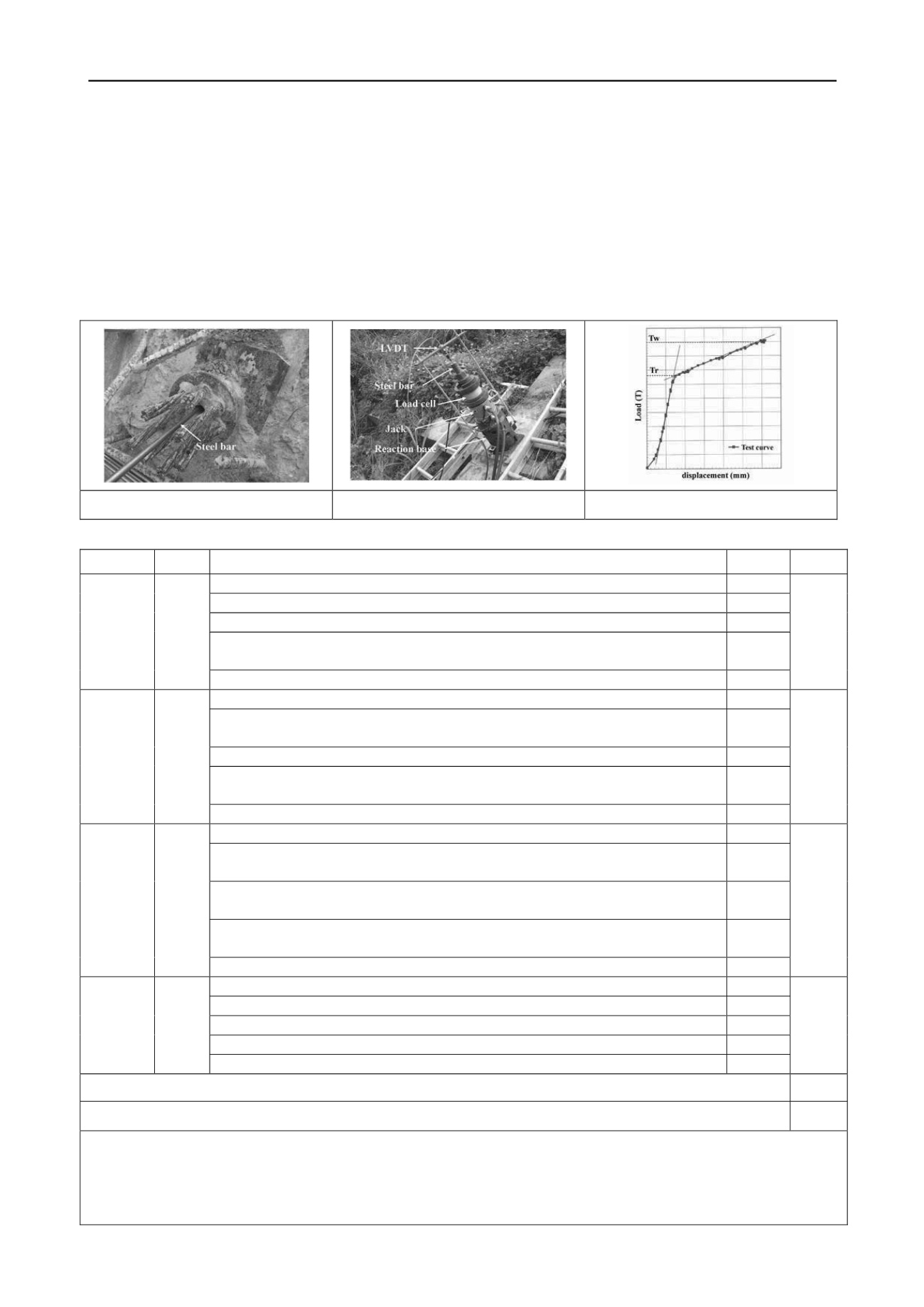
2287
Technical Committee 208 /
Comité technique 208
4 GROUND ANCHOR CAPACITY ASSESSMENT
PROCEDURE AND CASE STUDY
For the purpose of quantitative assessment on the ground anchor
capacities, and with regard to the ground anchors performance
on the sloping terrain application is the goal of this procedure.
Based on the inspection and assessment items, this article shall
introduce a new set of ground anchor capacity assessment
procedure, in hoping to establish a standardized way to
quantitatively evaluate and assess ground anchoring. Such
procedure shall comprised of exterior inspection, anchor head
inspection, endoscopy inspection and lift-off test. The findings
based on Table 1 distribution is point based. The total score
will then be carried to Table 2 to evaluate (β) and classification.
Sloped terrain performance and ground anchoring total capacity
shall be classified based on Table 2 standards. Ground
anchoring total performance assessment classified as A or B
grade, respectively, will be given corresponding effective
rehabilitation to ensure the full and reliable capacity of the
ground anchors.
Figure 4. Free section exposed portion length
investigation
Figure 5. Lift-off test installation
Figure 6. Lift-off test curve diagram
Table 1. Score of anchor capacity assessment
item
scoring Content of inspection
Weight
subtotal
Buckled or detached.
0
Greater than 2mm separation from bearing plate or water corrosion is severe.
0.25
Anchor head protected seat and bearing plate separation is less than 2mm.
0.50
Anchor head protected seat surrounded by water seepage, efflorescence or anchor seat outside is
slightly damaged or water corrosive level is moderate.
0.75
Exterior
inspection
10
No observable anomalies or water quality is normal.
1.0
Assembly came apart(clamp became loosened, steel tendon shrinkage or broken)
0
Anchor head surface appeared rusted and cracked, spread over 50% of the surface, steel tendon
section is deformed due to corrosion.
0.25
Anchor head surface appeared rusted and cracked, but spread less than 50% of the surface.
0.50
Slightly corroded or water seepage. Anchor head appeared rusted, but the depth of the rust is quite
thin, not measurable or lesser than 0.1mm.
0.75
Anchor
head
assembly
inspection
15
No corrosion or water seepage is present.
1.0
Steel tendon broken or steel threads became loosened and completely rusted.
0
Steel tendon appeared dark brownish, the surface already appeared corral-like or lumpy or rusted
surface spread over 90%.
0.15
Steel tendon appeared dark brownish, the surface is rough, but not appearing corral-like or lumpy or
rusted surface is between 50~90%.
0.45
Steel tendon appeared light brownish, but the surface is smooth and shining or rusted surface is
between 10~50%.
0.75
Endoscopy
inspection
30
No anomaly presence or rusted surface is below 10%.
1.0
Detached, steel tendon broken or Tr=0.
0
Tr>1.2Tw or Tr
≦
0.2Tw
0.33
0.2Tw<Tr
≦
0.5Tw
0.67
0.5Tw<Tr
≦
0.8Tw
0.75
lift-off
test
45
0.8Tw<Tr
≦
1.2Tw
1.0
Single ground anchor capacity assessment(β)
Total score of anchor capacity assessment(α)
Remark: 1. If any of the items in categories 1,2,3,4 assessed a score of 0, such ground anchor shall be deemed as defective, and the total score of the
anchor shall be zero.
2. When a sloped terrain of which 1/3 of the ground anchors inspected has reach over 90% rusted surface under the examination of
endoscopy, but the lift-off test revealed remaining capacity falls into the range 0.8Tw<Tr
≦
1.2Tw, additional investigations in the field and
test data is recommended to determine whether the slope may have a tendency to slide.


